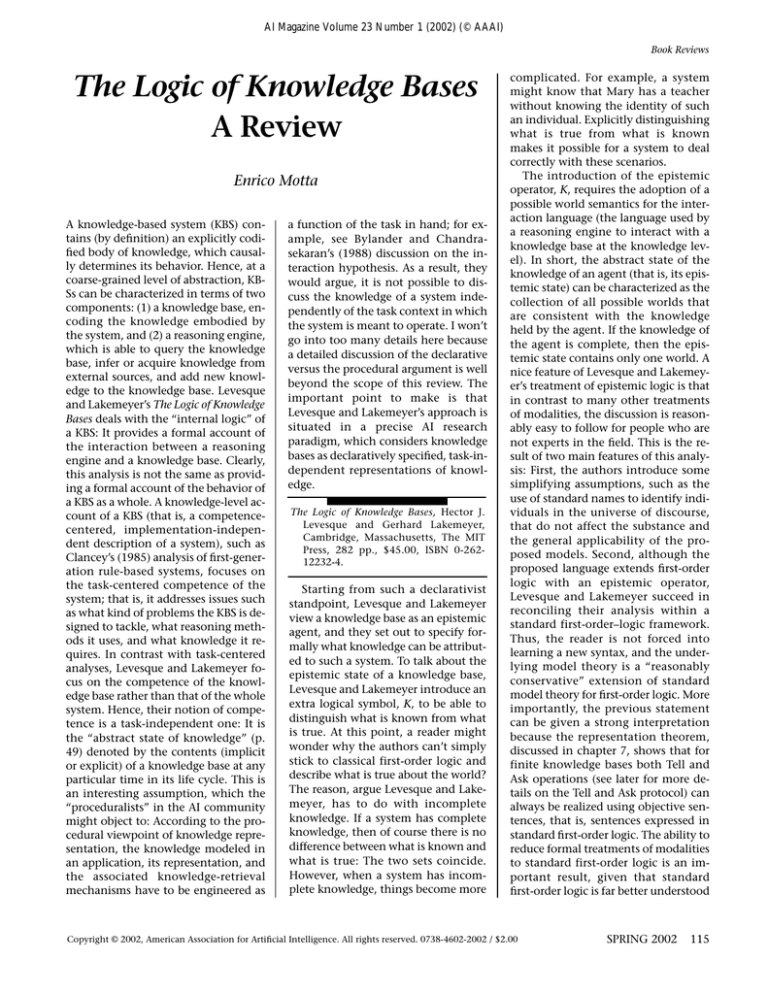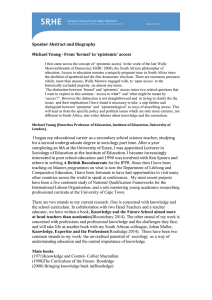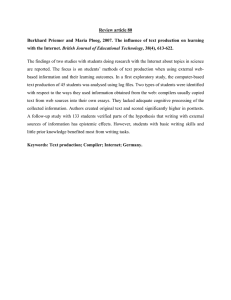
AI Magazine Volume 23 Number 1 (2002) (© AAAI)
Book Reviews
The Logic of Knowledge Bases
A Review
Enrico Motta
A knowledge-based system (KBS) contains (by definition) an explicitly codified body of knowledge, which causally determines its behavior. Hence, at a
coarse-grained level of abstraction, KBSs can be characterized in terms of two
components: (1) a knowledge base, encoding the knowledge embodied by
the system, and (2) a reasoning engine,
which is able to query the knowledge
base, infer or acquire knowledge from
external sources, and add new knowledge to the knowledge base. Levesque
and Lakemeyer’s The Logic of Knowledge
Bases deals with the “internal logic” of
a KBS: It provides a formal account of
the interaction between a reasoning
engine and a knowledge base. Clearly,
this analysis is not the same as providing a formal account of the behavior of
a KBS as a whole. A knowledge-level account of a KBS (that is, a competencecentered, implementation-independent description of a system), such as
Clancey’s (1985) analysis of first-generation rule-based systems, focuses on
the task-centered competence of the
system; that is, it addresses issues such
as what kind of problems the KBS is designed to tackle, what reasoning methods it uses, and what knowledge it requires. In contrast with task-centered
analyses, Levesque and Lakemeyer focus on the competence of the knowledge base rather than that of the whole
system. Hence, their notion of competence is a task-independent one: It is
the “abstract state of knowledge” (p.
49) denoted by the contents (implicit
or explicit) of a knowledge base at any
particular time in its life cycle. This is
an interesting assumption, which the
“proceduralists” in the AI community
might object to: According to the procedural viewpoint of knowledge representation, the knowledge modeled in
an application, its representation, and
the associated knowledge-retrieval
mechanisms have to be engineered as
a function of the task in hand; for example, see Bylander and Chandrasekaran’s (1988) discussion on the interaction hypothesis. As a result, they
would argue, it is not possible to discuss the knowledge of a system independently of the task context in which
the system is meant to operate. I won’t
go into too many details here because
a detailed discussion of the declarative
versus the procedural argument is well
beyond the scope of this review. The
important point to make is that
Levesque and Lakemeyer’s approach is
situated in a precise AI research
paradigm, which considers knowledge
bases as declaratively specified, task-independent representations of knowledge.
The Logic of Knowledge Bases, Hector J.
Levesque and Gerhard Lakemeyer,
Cambridge, Massachusetts, The MIT
Press, 282 pp., $45.00, ISBN 0-26212232-4.
Starting from such a declarativist
standpoint, Levesque and Lakemeyer
view a knowledge base as an epistemic
agent, and they set out to specify formally what knowledge can be attributed to such a system. To talk about the
epistemic state of a knowledge base,
Levesque and Lakemeyer introduce an
extra logical symbol, K, to be able to
distinguish what is known from what
is true. At this point, a reader might
wonder why the authors can’t simply
stick to classical first-order logic and
describe what is true about the world?
The reason, argue Levesque and Lakemeyer, has to do with incomplete
knowledge. If a system has complete
knowledge, then of course there is no
difference between what is known and
what is true: The two sets coincide.
However, when a system has incomplete knowledge, things become more
complicated. For example, a system
might know that Mary has a teacher
without knowing the identity of such
an individual. Explicitly distinguishing
what is true from what is known
makes it possible for a system to deal
correctly with these scenarios.
The introduction of the epistemic
operator, K, requires the adoption of a
possible world semantics for the interaction language (the language used by
a reasoning engine to interact with a
knowledge base at the knowledge level). In short, the abstract state of the
knowledge of an agent (that is, its epistemic state) can be characterized as the
collection of all possible worlds that
are consistent with the knowledge
held by the agent. If the knowledge of
the agent is complete, then the epistemic state contains only one world. A
nice feature of Levesque and Lakemeyer’s treatment of epistemic logic is that
in contrast to many other treatments
of modalities, the discussion is reasonably easy to follow for people who are
not experts in the field. This is the result of two main features of this analysis: First, the authors introduce some
simplifying assumptions, such as the
use of standard names to identify individuals in the universe of discourse,
that do not affect the substance and
the general applicability of the proposed models. Second, although the
proposed language extends first-order
logic with an epistemic operator,
Levesque and Lakemeyer succeed in
reconciling their analysis within a
standard first-order–logic framework.
Thus, the reader is not forced into
learning a new syntax, and the underlying model theory is a “reasonably
conservative” extension of standard
model theory for first-order logic. More
importantly, the previous statement
can be given a strong interpretation
because the representation theorem,
discussed in chapter 7, shows that for
finite knowledge bases both Tell and
Ask operations (see later for more details on the Tell and Ask protocol) can
always be realized using objective sentences, that is, sentences expressed in
standard first-order logic. The ability to
reduce formal treatments of modalities
to standard first-order logic is an important result, given that standard
first-order logic is far better understood
Copyright © 2002, American Association for Artificial Intelligence. All rights reserved. 0738-4602-2002 / $2.00
SPRING 2002
115
Book Reviews
and computationally tractable than
modal logics. Having said so, one
slightly confusing aspect of Levesque
and Lakemeyer’s analysis is that although Levesque and Lakemeyer talk
about modeling knowledge, they are
actually modeling beliefs. For those
used to “classical” theories of knowledge, this is slightly confusing because
in Levesque and Lakemeyer’s treatment, an agent might know something that is not true, but in many other treatments, everything known must
be true (that is, the real world is always
one of the possible worlds available to
an epistemic agent). This is a bit disconcerting at first, but eventually the
reader gets used to it; that is, he/she
eventually rests assured that it is
Levesque and Lakemeyer’s epistemic
agents who might be affected by solipsism rather than he or she.
The problem of how to handle formally and effectively incomplete
knowledge is one of the two main goals
of the book. The other has to do with
precisely characterizing the behavior of
a knowledge base at the knowledge level. The perspective of a knowledge-level
view of intelligent systems was first
proposed by Allen Newell in 1981 and
has since informed much work in
knowledge representation. In contrast
with Newell’s goal-oriented view of a
knowledge-level system as an epistemic
agent, as already mentioned, Levesque
and Lakemeyer are not concerned with
goal-driven behavior. For them, a
knowledge base is essentially a task-independent body of knowledge to be interacted with by means of two basic operations: Tell, to add new knowledge,
and Ask, to find out what the system
knows or what is true about the world.
Chapter 5 in the book formally specifies Tell and Ask as operations that take
as arguments a sentence and an epistemic state and return either an element in the set {yes, no} (Ask) or a new
epistemic state (Tell).
The first half of the book covers the
basics, and the second half shows applications of the framework to nonmonotonic reasoning, tractable reasoning, and reasoning about actions. I
won’t go into too many details here,
but essentially Levesque and Lakemeyer show how their framework can be
used to reconstruct approaches such as
116
AI MAGAZINE
Robert Moore’s epistemic logic and
John McCarthy’s situation calculus. Of
particular interest are chapters 12 and
13, which discuss a semantic approach
to logical omniscience. A standard
problem in knowledge representation
is the trade-off between expressivity
and computational efficiency. Most
solutions err either on the side of expressivity (that is, you might wait a
long time for an answer) or efficiency
(that is, you are guaranteed an answer,
but there is a lot that you are prevented from representing). Levesque and
Lakemeyer show that it is possible to
distinguish between explicit and implicit beliefs by providing a four-valued semantics (in addition to standard
true and false truth assignments, sentences can now be either true and false
or neither true nor false). The distinction between implicit and explicit beliefs enables very efficient decision
procedures for explicit beliefs in the
context of a very expressible language.
Thus, what is the general assessment
of this book, and what audience is the
book relevant to? The answer to the
first question is quite easy. This is clearly a very good book, which provides a
powerful, formal, and detailed (but reasonably easy-to-follow) logical treatment of some of the thorniest issues in
knowledge representation: incomplete
knowledge, nonmonotonic reasoning,
reasoning about actions, and logical
omniscience. The answer to the second
question is a bit more complicated. The
book is definitely going to be required
material for anybody interested in formal knowledge representation or in
formal theories of knowledge. However, what about the wider world of
knowledge-based systems? After all,
one would expect a book with the
words knowledge base in the title to be
of interest to the wider community of
researchers and practitioners in the
area of knowledge-based systems. In
addition, it would be nice if such interest was not going to be driven purely
by intellectual curiosity but also by the
possibility of applying these results to
the engineering of real systems in real
contexts. Unfortunately, no attempt is
made in the book to link the analysis
either to concrete applications or to research in task-performing knowledgebased systems, for example, the work
by Bill Clancey, Mark Stefik, and Balaknishman Chandrasekaran in the
United States and by Bob Wielinga and
others in Europe (Bylander and Chandrasekaran 1980; Clancey 1985; Fensel
et al. 1999; Stefik 1995; Schreiber et al.
2000). Au contraire, the reader gets the
feeling that the authors are actually not
that interested in applications of
knowledge representation technology:
The examples in the book tend to be of
the “Tweety is a bird” variety, and none
of the 143 references seems to be related to some application.
In conclusion, this is an excellent
book, which is very much grounded in
the AI tradition of symbolic representation of knowledge. Anybody interested
in formal representations of knowledge
and epistemic agents should definitely
read this text. However, those readers
who are primarily interested in knowledge-based systems viewed as task-performing agents should definitely note
that the word systems does not follow
the words knowledge base in the title of
the book. This omission is indeed a significant one!
References
Bylander, T., and Chandrasekaran, B. 1988.
Generic Tasks in Knowledge-Based Reasoning: The Right Level of Abstraction for
Knowledge Acquisition. In Knowledge Acquisition for Knowledge-Based Systems, Volume 1, eds. B. Gaines and J. Boose, 65–77.
San Diego, Calif.: Academic.
Clancey W. J. 1985. Heuristic Classification.
Artificial Intelligence 27(1): 289–350.
Fensel, D.; Benjamins, V. R.; Motta, E.; and
Wielinga, B. 1999. UPML: A Framework for
Knowledge System Reuse. Paper presented
at the Sixteenth International Joint Conference on Artificial Intelligence (IJCAI-99), 31
July–5 August, Stockholm, Sweden.
Schreiber, G.; Akkermans, J. M.; Anjewierden, A. A.; de Hoog, R.; Shadbolt, N. R.; Van
de Velde, W.; and Wielinga, B. J. 2000.
Knowledge Engineering and Management: The
COMMONKADS Methodology. Cambridge,
Mass.: MIT Press.
Stefik M. 1995. Introduction to Knowledge
Systems. San Francisco, Calif.: Morgan Kaufmann.
Enrico Motta is the director of the Knowledge Media Institute (KMi) of the Open
University in the United Kingdom. His
main interest is in knowledge technologies,
and his current research focuses on the
specification of reusable knowledge-based
components.



